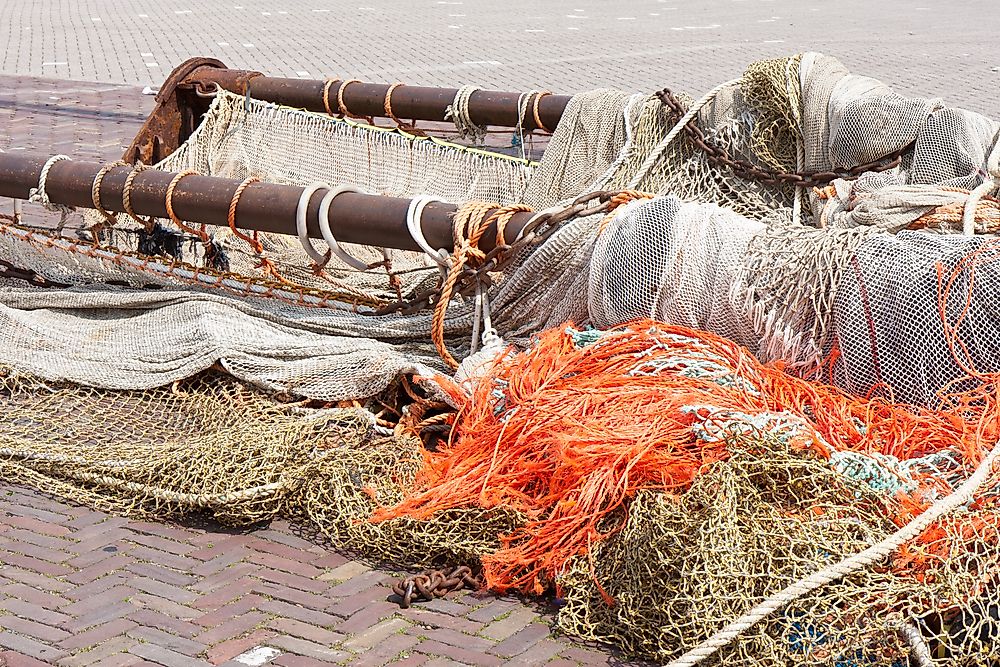What Are The Impacts Of Bottom Trawling On The Environment?

Trawling is a fishing technique in which a boat pulls a net through the water to trap and catch fish. The net can be pulled anywhere in the water column of the ocean, including the midwater or bottom sections. When the net is towed along the sea floor, the technique is called bottom trawling. There are two types of bottom trawling: benthic and demersal. Benthic trawling involves towing a net at the very bottom of the ocean, while demersal trawling is the process of towing the net just above the benthic zone.
While midwater trawling catches pelagic fish like mackerel, bottom trawling catches groundfish species and invertebrates like cod, rockfish, and shrimp. Boats used for bottom trawling are called trailers and their size can range from small to the scale of large factories. Often, two trawlers can be paired by a net to conduct a more effective bottom trawling technique.
Over 30 million tonnes of fish and marine invertebrates are caught each year by bottom trawling. Although trawling supports a thriving fishing industry, it comes at a heavy cost to the environment, as described below.
1. Bottom Trawling Leads to Overfishing
Since trawl nets are usually very large and trawlers move these nets across long distances, large numbers of fish are caught through bottom trawling. The intensity of such operations can rapidly deplete fish stocks, and overfishing can also lead to the elimination of fish species in the long run.
2. Unwanted Marine Life Caught as "Bycatch"
One of the biggest issues associated with bottom trawling is "bycatch." Since only certain species of fish among the thousands living in the ocean are edible and can be sold in the market, the rest that are caught are of no use to the fishing industry. This unwanted catch is called "bycatch." The fishing nets used in bottom trawling are unable to distinguish between species, and therefore many species of fish, marine invertebrates, marine mammals, reptiles, and even seabirds are caught in such nets. Seabirds can become caught when attracted to the fish in the net while it is hauled into the boat. In most cases, almost half of the catch from bottom trawlers is unwanted. Bycatch is usually shoveled back into the ocean, but it does lead to the death of thousands of marine animals in the process. Today, bycatch is one of the primary reasons for the deaths of millions of dolphins, sharks, whales, and other marine fauna, and has pushed many species to the brink of extinction. Shrimp fisheries are one of the worst types of bottom trawling operations. Since the mesh size of the fishing nets used to catch shrimp is very small, larger fish cannot escape if caught in the net. At times, shrimp fishing catches 10 fish for every one shrimp. The catch often includes the offspring of fish that have no market value. As a result, such wasteful fishing operations are leading to the depletion of marine fauna populations.
3. Bottom Trawling Destabilises the Seafloor
The seafloor is a very stable system. It is the calmest part of the sea, where currents, temperature, and other natural conditions remain relatively undisturbed. However, when heavy nets are dragged along the sea floor, they stir up sediments as well as the water, resulting in a destabilization of the sea floor.
4. Marine Flora and Fauna Living on the Ocean Floor Die
Bottom trawling operations uproot and displace marine flora and fauna living on the ocean floor. Sea anemones, sea pens, sponges, urchins, and other fragile-bodied marine fauna are destroyed during the trawling process. Many species of corals are specialized to grow on the ocean floor and can form massive colonies that survive for centuries. However, bottom trawling can uproot and kill these centuries-old coral colonies within a matter of seconds. Deep sea corals play an extremely vital part in the deep sea ecosystem, as coral reefs and coral groves on the seabed serve as the hiding and spawning grounds of many species of fish. Hence, the destruction of such corals adversely affects the species dependent on them.
5. Bottom Trawling Puts the Livelihoods of Local Fishing Industries at Stake
Bottom trawling requires sophisticated technology and is highly profitable. Therefore, large companies compete with each other to gain control of area of seas that are rich in fish. Often, the winner ensures that no other competitors can fish these areas in order to maximize profits. Local fishing businesses with traditional fishing equipment and small boats cannot compete with large fishing companies, and are therefore squeezed out and suffer economic losses.











